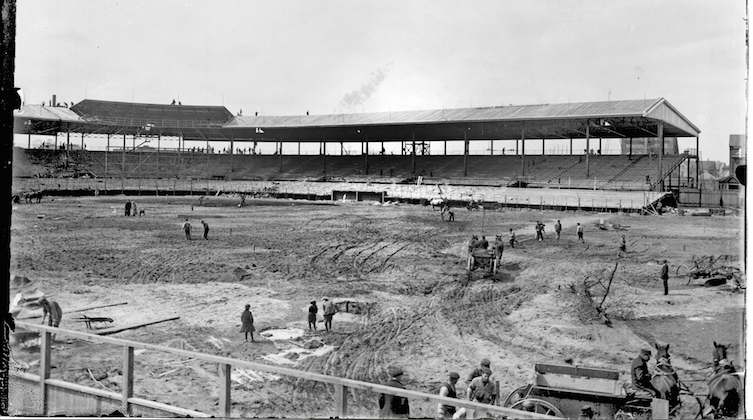April 23, 2014 marks a special occasion for the city of Chicago: the centennial anniversary of baseball being played at the corner of Clark and Addison. Before Ernie Banks and Harry Caray, before Ron Santo and Billy Williams, before Bartman, before the Billy Goat, and before the Cubs even played on the North Side at all, there stood the field now known as Wrigley.
A century is a long time—the nation has certainly changed since they broke ground at the stadium, and the National Pastime itself is nearly unrecognizable. A look back to the first home opener, April 23rd, 1914, is a view to a bygone time—a period when baseball was still in the dead-ball era, when the North Side was still a fledgling section of the city, and when an Old Style didn’t cost $7.75.
Here’s a rundown of what things were like at the very first opening of the Friendly Confines:
- The name Wrigley was nowhere to be seen on the baseball park—the gum magnate wouldn’t become involved with the Cubs for a few years yet. Instead, it was Weeghman Park then, named for “Lucky” Charley Weeghman, the “lunchroom king of Chicago”.
- You wouldn’t find the lovable-loser Cubs playing on the North Side in 1914 (in fact, they weren’t even losers yet—the turn of the 20th century found the West Side Cubs at their best). Fans flocked to the park to watch the Chicago Feds (name later changed to the equally un-catchy Chicago Whales) play the Kansas City Packers in a matchup of teams from the upstart and short-lived Federal League.
- The park looked almost nothing like it does today. At Weeghman Park’s opening, the new facility consisted of a curved, roofed grandstand, and bleachers along the first and third baselines and in right field. No upper deck, no clock on the scoreboard. Even the ivy wouldn’t line the outfield wall until the ‘30s. All told, Weeghman Park in 1914 measured 310 feet to left, 345 to right, 400 feet to center, and could hold between 14,000 and 16,000. Still, built from concrete and steel it was renowned in its time as the crown jewel of the North Side, and easily trumped the rickety West Side Grounds, where the Cubs were then playing.
- After arriving via either a five-cent streetcar or hopping off of what was then called the Northwestern Elevated Railroad at Addison, Chi-Fed fans could expect to pay 50 cents for bleacher seats, 75 cents for a spot in the grandstands, or a whole dollar for box seats. Just for the sake of comparison, a box seat for a Wrigley game on April 23, 2014 will run $1,203.20.
- Fans that day were excited to see Claude Hendrix, a spitballer, take the mound. Completing the battery was Art Wilson behind the plate, and an outfield manned by the likes of Max Flack and sweet-swinging Dutch Zwilling. Baseball names were better back then.
- Opening day was a wild success. The game sold out a half-hour before the first pitch, barring thousands of fans from entry. But those fans quickly forged a longstanding Wrigley tradition: they watched the game from the rooftops along Sheffield and Waveland.
- “A club management must show plainly that the first thought is for the fan’s comfort” Charley Weeghman told the Chicago Post shortly before his park opened, and he delivered on that directive. Spectators at the inaugural game received free Chi-Fed caps and pennants, a bit of schwag which seems expected now, but was groundbreaking at the time.
- Weeghman went to great lengths to out-class the West Side Grounds, then-home of the Cubs. Sean Deveney, in his Before Wrigley Became Wrigley , describes the West Side Grounds as dusty, dirty, smelly, and “known, too, for rude ushers and pushy vendors selling cigars, popcorn, and programs in the aisles, blocking the fans’ view of the game.” Weeghman’s park, then, would be different. Indeed, it was the site of the first ballpark concession stand, and Weeghman further employed a team of men to clean the stadium each day.
- The grounds were kept ship-shape by a horse. The horse’s name was Queen Bess, and she had a stable beneath the third base bleachers. Bess previously pulled a pie cart in the Loop, and now stands as an example of the upward mobility available to horses in the early 20th century.
- The pre-game festivities were lavish and all over the place. Entertainment included a parade, ten bands, a 21-gun salute, a rendition of “Columbia, Gem of the Ocean,” by the Ladies of the Grand Army of the Republic—but the real star of the pre-game show was a fake bullfight orchestrated by a group known as the Bravo el Toro Club, who used a fatted steer instead of a bull. This is Chicago, after all.
It was 1916 when the Cubs would move to the North Side, but the tradition of baseball truly started two years earlier, with the Chi-Feds banishing Kansas City by a score of 9-1. Commenting on the successful start of baseball at Clark and Addison, Trib reporter Sam Weller colorfully wrote in 1914 that “Chicago took the Federal league [sic] to its bosom yesterday and claimed it as a mother would claim a long lost child.”
Indeed, like a hungry child to its mother, baseball clung to the North Side. And one hundred years later, it’s still there sucking.



